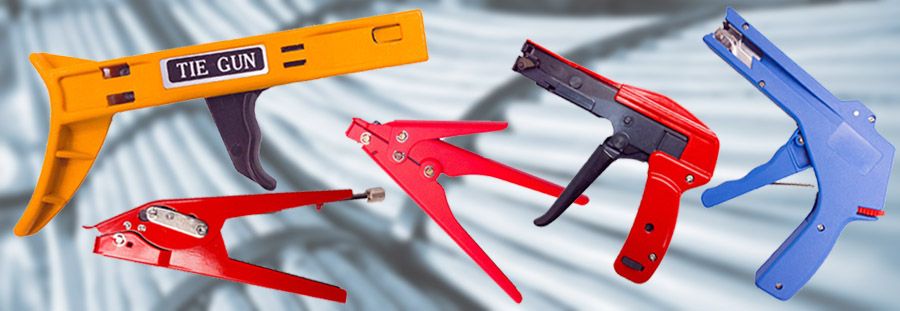
Cable ties are used in numerous industries, from construction and manufacturing to data centres and telecommunications. Used for bundling, securing, and organizing cables, their effectiveness hinges on proper application. This is where cable tie tools come in, streamlining the process and ensuring secure fastening. This guide is designed to provide procurement managers and equipment buyers within organisations with the knowledge to make informed decisions when purchasing cable tie tools.
What Cable Tie Tools Do
Cable tie tools simplify and expedite the application of cable ties. They eliminate the need for manual tightening, reducing fatigue and potential injuries, particularly for tasks involving repetitive cable bundling.
These tools function by:
- Feeding the cable tie through the tool: This creates a smooth and efficient way to guide the tie around a bundle of cables.
- Tightening the cable tie: Tools provide a controlled tightening mechanism that ensures consistent tension across various tie sizes.
- Cutting off the excess cable tie tail: This creates a clean and professional finish.
Types of Cable Tie Tools
There are two main types of cable tie tools:
- Manual Cable Tie Tools: These are cost-effective and portable options ideal for low-volume cable management tasks. They typically consist of a simple hand-operated mechanism for tightening and cutting the tie.
- Pros: Affordable, lightweight, require no external power source.
- Cons: Can be time-consuming for large-scale projects, repetitive use can lead to hand fatigue, limited features compared to automatic tools.
- Automatic Cable Tie Tools: These are powered tools that offer increased efficiency and productivity on high-volume cable management projects. They provide various functionalities, depending on the model.
- Pros: Faster application time, reduced user fatigue, consistent tension control, some models offer programmable settings for specific tie tightness or bundle sizes.
- Cons: Higher initial cost, heavier than manual tools, may require an external power source like compressed air or rechargeable batteries.
Advantages of Automatic Cable Tie Tools
While manual cable tie tools serve a purpose for occasional use, automatic tools offer significant advantages for organizations:
- Increased Productivity: Automatic tools significantly reduce the time required for cable tie application, leading to faster project completion.
- Improved Ergonomics: The automatic tightening mechanism eliminates repetitive hand motions and reduces fatigue for workers.
- Consistent Tension: Pre-set tension settings ensure all cable ties are secured with the same tightness, improving cable management reliability.
- Reduced Risk of Injury: Automatic tools remove the need for manual force, minimizing the risk of repetitive strain injuries.
- Professional Appearance: Clean and consistent cuts of the cable tie tails resulting in a professional aesthetic in your installations.
Factors to Consider When Purchasing Cable Tie Tools
When choosing cable tie tools for your organisation, consider the following factors:
- Volume of Cable Management Tasks: If you have frequent or high-volume cable management needs, automatic tools will provide a better return on investment.
- Cable Tie Size and Material: Ensure the tool accommodates your typical cable tie size and material (nylon, stainless steel, etc.). Some tools have limitations on maximum tie width or thickness.
- Power Source: Automatic tools come in various power options - electric, pneumatic (compressed air), or battery-powered. Choose the option that best suits your environment and availability of power sources.
- Ergonomics: Consider the tool's weight and grip design for long-term user comfort. NPA recommends a body moulded from plastic sealing pressed steel parts for both comfort and durability.
- Additional Features: Some automatic tools offer features like automatic feed, loop tension adjustment, or pre-programmed tightness settings. Evaluate if these features are beneficial to your needs.
- Durability and Warranty: Choose well-established brands such as NPA for robust cable tie tools with steel mechanical parts. A longer warranty ensures peace of mind in case of malfunction.
Budget Considerations
Automatic cable tie tools have a higher initial cost compared to manual options. However, the long-term benefits need to be considered. The time savings, improved efficiency, reduced fatigue, and improved professionalism can justify the cost for organisations dealing with regular cable management tasks.
Conclusion
Cable tie tools are an investment that can significantly streamline and improve the efficiency of your cable management processes. By carefully considering the factors mentioned above, you can choose the right cable tie tools that deliver cost-effectiveness, improve productivity, and ensure a professional finish to your cable installations.
Additional Tips
- Research: Compare features and functionality of various brands before making a purchase.
- Invest in Training: Provide adequate training to your employees on the proper use and maintenance of cable tie tools. This ensures optimal performance and tool longevity.
You can check out the automatic cable tie tool NPA recommends and sells here Automatic Cable Tie Tool Automatic | NPA

